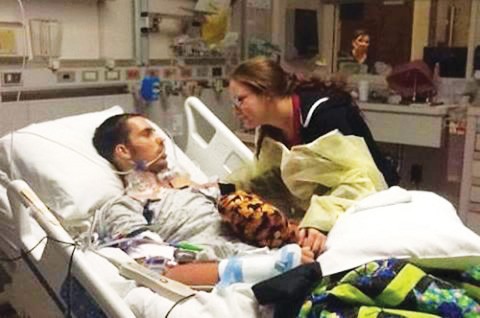In April of last year, Bryan Chabot, a 27-year-old from East Tucson, wasn’t feeling well.
With symptoms of high fever and vomiting, he was constantly drowsy and tired, said Nichole Romeo, Bryan Chabot’s fiancee.
At the time, Bryan Chabot wasn’t eligible for Arizona’s state insurance, Arizona Health Care Cost Containment System, since he was legally childless, so the family attempted to diagnose him themselves. They guessed valley fever, but they were wrong.
Around June, Bryan Chabot was feeling worse.
The doctors at St. Joseph’s Hospital diagnosed Bryan Chabot with endocarditis — an infection found in the inner layer of the heart. It derived from a tooth infection Bryan Chabot was harboring.
“I’ve pulled my own teeth to avoid the dentist,” said Bryan Chabot. “You don’t know how many times I walked out of the dentist’s office before being seen.”
This time, there was no walking out. An oral surgeon came and pulled three of Bryan Chabot’s infected teeth.
But he still wasn’t in the clear. Serious heart problems remained.
For six weeks in the hospital, doctors gave him antibiotics for his now-infected aortic valve. In the midst of treatment, the doctors at St. Joseph’s also found an aneurysm on his aorta, the main blood vessel that branches off the heart. An aneurysm can cause the walls of the vessel to weaken, and a tear in the aorta wall can be fatal in minutes.
Still without insurance, the family went home.
“He was getting really bad side pains, couldn’t keep food down, had trouble breathing, [and was] sweating and swelling,” said Dave Chabot, Bryan Chabot’s father.
From there, Bryan Chabot’s condition went downhill fast.
“His blood sugar was really low and he was hallucinating,” Romeo said. “He went into diabetic shock and crashed, crashed again, and went into the Intensive Care Unit.”
Bryan Chabot had congestive heart failure. The doctors placed him on a ventilator and put him into a medically induced coma because his liver, kidneys and respiration were also failing, Romeo said.
“Bryan needed surgery, but the St. Joe’s surgeon told me he was too sick to operate,” she said.
Not only did the family need a heart surgeon, they needed insurance. So Dave Chabot spoke twice to Arizona Gov. Jan Brewer, asking for emergency AHCCCS for his son. Dave Chabot also spoke with KVOA News 4 Tucson, which published an article describing Bryan Chabot’s desperate situation.
“But nothing was happening, and we didn’t have much time,” Dave Chabot said.
On Oct. 26, Bryan Chabot was transferred to the University of Arizona Medical Center, where Dr. Sreekumar Subramanian was willing to operate.
“One of the things about being at the University of Arizona Medical Center is that we don’t want to be turning down patients that are sent to us,” Subramanian said. “We have the special expertise to be able to do these operations. We are not going let a 27-year-old patient die. We’re going to give him the best shot at survival.”
The best shot was not to rush, Subramanian said. They needed most of his organs to stabilize for a higher chance of surviving after the surgery. Further complicating the situation, the doctors discovered he had a narrowing of his aorta, which they determined to be genetic.
Subramanian concluded that Bryan Chabot needed not one, but two high-risk surgeries. His chance for mortality, Subramanian said, was 50 percent.
On Nov. 1, Subramanian performed the first surgery to replace Bryan Chabot’s destroyed aortic valve. With the new valve in place, Bryan Chabot’s failing organs began to recover.
It was good news, but he wasn’t done.
The second surgery addressed two problems: Bryan Chabot’s narrowed aortic vessel and the aneurysm, which the family and doctors believe came from an ATV accident Bryan Chabot had when he was 12, Subramanian said.
The second surgery was successful, and Bryan Chabot recovered enough to share Thanksgiving dinner with his family.
Bryan Chabot, who recently returned to work as a land surveyor, said the experience taught him and his family two things.
One: Hospital bills are unfathomably expensive.
“Just the last one was for $570,000,” Bryan Chabot said with an astonished grin.
Two: Don’t sweat the small stuff.
“You never know how fast your life can change in a year’s time,” Dave Chabot said. “It changes in a heartbeat.”
Follow Dara Farhadi @Dara_Farhadi









